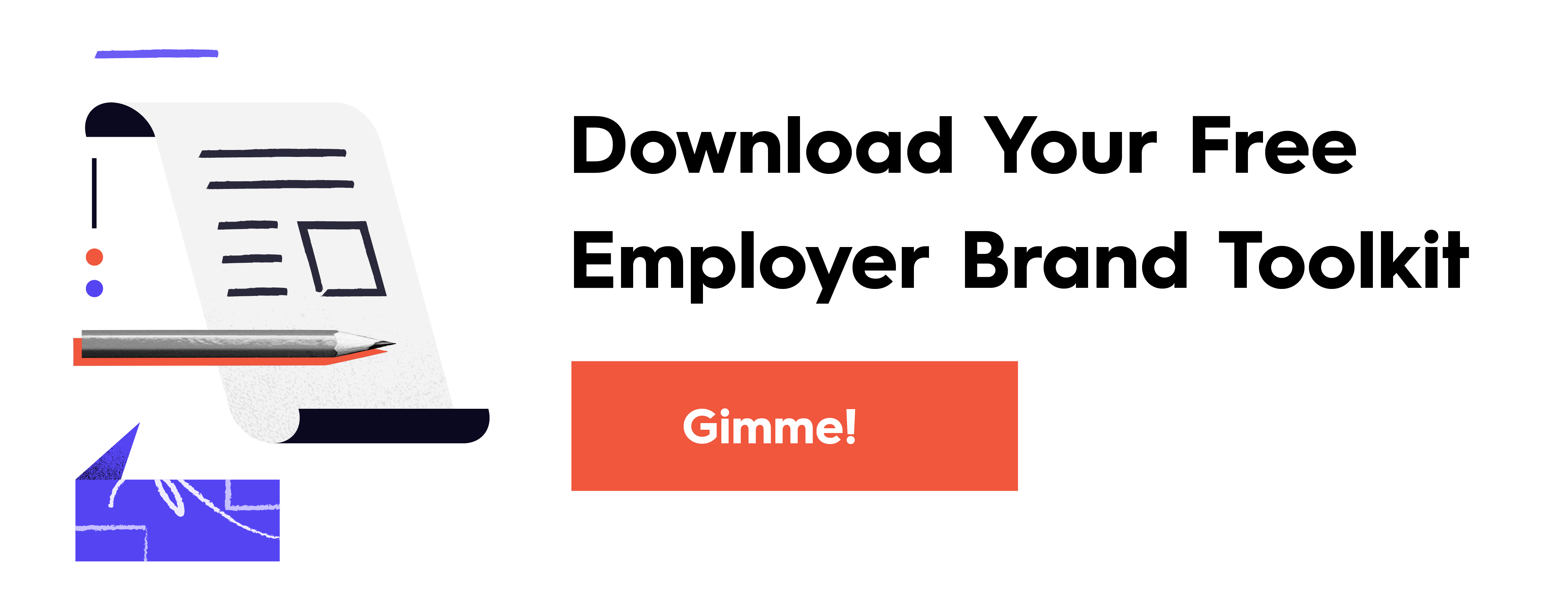Finding, hiring, and keeping the best people is more challenging than ever. Employees are more empowered to find new work, competition makes it harder for brands to stand out, and social media makes it easier to expose how brands treat employees. How do you keep your team aligned and create a place where people want to work? Invest in an employer brand strategy.

The Keys to a Strong Employer Brand Strategy
Employer branding is a way to tell your brand’s story authentically and entice people to join your team. But here’s the thing: When it comes to promoting your brand, you can’t sell people on who you want to be; you can only sell them on who you are.
Creating a truly healthy, happy employer brand requires deep work, fearless self-inventory, and the cultivation of a few key traits. Focus on these elements, and you’ll be able to recruit, retain, and engage your employees with confidence.
1) Brand Heart
According to a 2019 Glassdoor study, 73% of adults would not apply to a company unless its values aligned with their own personal values. As more and more people are searching for more meaning in their work, leading with your Brand Heart (your purpose, vision, mission, and values) is crucial.
These beliefs are the backbone and moral compass of your employer brand. The better you can communicate them, the easier it will be to attract like-minded people.
How to Do It
If you haven’t already, use our free Brand Heart workbook to get your principles on paper.
2) Clarity
What makes your brand unique? Why should someone work for you instead of your competition? What will they get if they decide to take the job? Clarity is the key to understanding your employer brand and telling the right stories to reinforce it.
How to Do It
The same way you would create a value proposition for your product or service, you should craft a unique employee value proposition. This will make it easier to pitch potential employees and communicate exactly what they can expect from you. Follow this step-by-step guide to craft an employee value proposition that will help you make a better impression.
3) Honesty
Your integrity is everything. If you want credibility and respect, you need to be honest with everyone from your customers, to your vendors, to your employees. Hence, you can’t lie or misrepresent your employer brand. Employees will feel manipulated or betrayed if you don’t present an accurate picture of your brand. Plus, tools like Glassdoor make it easier to call you on your BS—and potentially expose your brand to even more criticism.
How to Do It
To get a clear and honest picture of your brand, do an employer brand audit to poll your current and former employees about their experience working for you. (Remember that the way you part with employees is just as important as the way you onboard them, so look at the whole employee journey.) This exercise should give you an honest picture of your strengths and weaknesses, and inspire you to work on the areas where you’re lacking.
4) Consistency
One of the most important aspects of branding is consistency. Again, talk can only get you so far. It’s how you walk the talk that matters. If you claim to be a brand that promotes the spirit of adventure, but you don’t offer much paid vacation, people will clock it. If you emphasize innovation but have application software that is clunky, potential employees may be turned off. Look at your entire employee lifecycle, from application to the exit interview, and make sure you’re providing an experience that truly reflects your brand.
How to Do It
Think about how you’re positioning your employer brand, and assess whether or not that aligns with your Brand Heart, your benefits, your culture, etc. When you tell these stories, make sure you’re consistent in not just what you say but how you say it. To do that, follow our tips to create content that is on brand, every time.
5) Accountability
If you want to attract people who are responsible and accountable (and who doesn’t?), you have to lead the way. This is why openly sharing your Brand Heart is powerful. It helps you attract the kind of people who are committed to your purpose, and it keeps you accountable to your own values. Even if your brand needs some rehab, leading with honesty will make potential candidates much more open to working with you.
How to Do It
Be courageous enough to look into the dark corners of your culture, own your mistakes, and take the steps needed to make positive changes. Remember: One of the most important attributes of a mature brand is the ability to be responsive to any situation, whether it’s an honest mistake or a major mess-up.
6) Generosity
A healthy relationship between an employee and a brand is grounded in trust, respect, and a spirit of generosity. They give you their time, hours, and expertise. You give them security in the form of compensation. But compensation is much more than just money. There are many ways you might care for your people, and those are all important parts of your employer branding story.
How to Do It
Beyond the standard salary, healthcare, and retirement benefits, think about the other perks you can highlight that align with your Brand Heart.
For example, work-life balance is a big deal to us. To encourage this, we support remote work, provide an annual “careosity” budget to spend on passions or skill training, create policies to support working parents, and participate in profit sharing so that people can see the direct fruits of their labors.
Even if you can’t offer more money than your competitors, these are examples of both big and small ways you can take care of your people.
7) Culture
Everything we’ve covered thus far contributes to your company culture, which is one of the most important parts of a strong employer brand. If you undervalue it, misrepresent it, or try to manufacture it, you will only hurt yourself. Your existing employees will be unhappy, your new hires will feel betrayed, and your reputation will be affected. (BTW, according to a 2019 Jobvite survey, 28% of people who quit a job in the first 90 days cite company culture as the reason why.)
But you can’t create your culture overnight; you need to nurture it intentionally and consistently over time.
How to Do It
Look for ways to infuse your culture across your organization, whether it’s through events or team-building exercises. (Here are 10 ways we do it.) Content is also a great way to share your culture. Whether it’s employee spotlights, peeks into your office life, or transparency into your hiring process, there are plenty of ways to do it. See our guide to culture marketing for more ideas.
How to Strengthen Your Employer Brand Strategy
You already have an employer brand, but if you’ve neglected it thus far, it’s other people who are telling the story. To show people who you really are, take the reigns and create content that communicates your value. If you need more inspiration…
- See our complete guide to build an employer brand strategy.
- Tell your origin story to show people how it all started.
- Try these tips to tell your brand story in every piece of content.
But if you don’t have the resources to dig in or the knowledge to navigate the bigger things, consider bringing in some expert support. Use these questions to vet a content agency, or holler at us. We’d love to help you tell your brand story.




